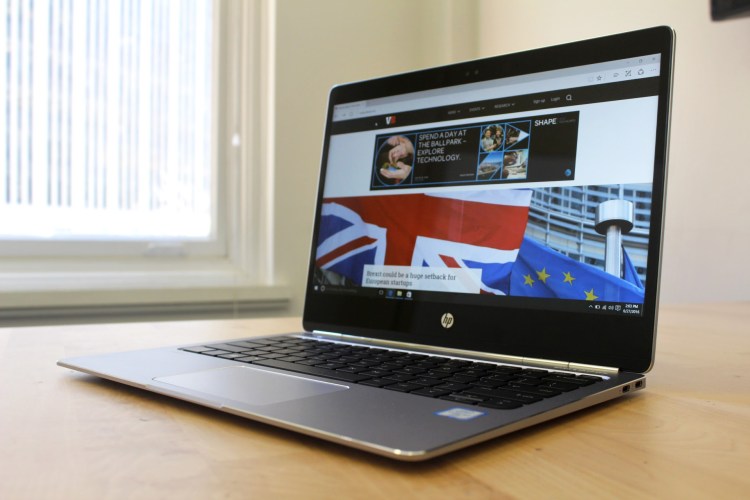HP has a solid answer to Apple’s light and thin MacBook: It’s called the EliteBook Folio G1.
The new EliteBook is just as portable as the MacBook, but it avoids some of its pitfalls, like the single USB-C port and shallow keyboard. And the EliteBook can do some things that Apple’s laptop just can’t.
But HP’s machine isn’t perfect, and its shortcomings stop us from wholeheartedly recommending it. At $999, however, the base model costs $300 less than the MacBook. So, it’s worth a closer look.
What’s good
The new EliteBook is nice and thin at 0.47 inches, and it’s quite light — 2.14 pounds. The aluminum casing feels smooth; it’s not the fortress that is the HP Spectre x360, but then again, it is lighter. And it’s more lappable than convertible tablets like Microsoft’s Surface and HP’s Spectre x2 and Elite x2 1012 G1.
The keyboard is the highlight of this laptop. I can type very quickly on it, and for me, that’s awesome, because I type for a living. The keys are light but bounce back well, like a fully pumped basketball. And they go down a good amount more than the MacBook’s keys, even though the EliteBook is slightly thinner than a MacBook’s thickest points.
The 12.5-inch 1920×1080 FHD display on the EliteBook Folio G1 is good enough. While it reflects some light, it’s plenty bright, and at 1080p, you can pack a lot of information onto the display. I found myself snapping windows next to each other frequently, and I never felt like I was sacrificing resolution. Also, unlike the MacBook, a touchscreen model is available.

Above: It lies flat.
If you’re used to a Mac, you will appreciate the EliteBook’s flexibility; you can push the display of this laptop 180 degrees back so it’s flush with the keyboard.
And the performance is fine for many general-purpose workloads. The model I tested has the brawniest chip available for this device: the Intel Core m7, accompanied by 8GB of RAM and 256GB of solid-state storage (SSD) — as configured, it would cost $1,469. (Core m5 models with different storage configurations are also available.)
Some games and extended browsing sessions will make the base of the computer hot. But even when that happens, the machine stays silent, because it’s fanless, just like the MacBook. This is a wonderful thing.
What I don’t like
There’s no way to sugarcoat this: The laptop needs more battery life. I’ve seen it drain in two hours. More commonly it lasts for four to six hours. And that’s not even with a 4K display onboard.
The bezel above and below the display is a bit wide for my taste. It’d be good to see a future model with more display and less bezel.

Above: The keyboard on HP’s EliteBook Folio G1.
The EliteBook’s trackpad recognizes multi-touch gestures but could be more precise when clicking, dragging, and dropping. And the trackpad’s palm rejection needs work — again and again I found myself resizing content in browser tabs by accident.
I don’t care for the two rubber bars along the bottom of the device — they keep the laptop in place, but they make it look and feel less sleek. I’d prefer the circular rubber legs you can find on the MacBook or HP’s Spectre x360.

Above: One of two speakers on the bottom of HP’s EliteBook Folio G1.
The Bang & Olufsen-tuned speakers on this device are loud and clear. But the moment you set it down on a carpet, a couch, or a bed, the sound gets muffled; the speakers are located on the bottom, and soft, squishy surfaces cover them up. Perhaps HP will relocate the speakers in the next version of this laptop.
Separately, sound wouldn’t come out of my review unit for a few hours at a time occasionally during the weeks I spent with the laptop, although HP says the issue is confined to this one device, and sure enough the problem didn’t crop up on a second review unit HP sent over.
It’s reassuring to have two USB-C ports in the EliteBook — the MacBook I reviewed last month had just one. With two ports, you can charge the laptop and charge your phone at the same time. Great. But HP knows how to pack a laptop with ports, and that is not what it’s done here — an SD card reader, an HDMI port, a dedicated Ethernet jack, and yes, a USB-A port would be useful additions that could help the device stand out from the MacBook.
Altogether
Inside HP, the EliteBook Folio G1 is known as a business laptop. It comes with features that will be amenable to a work setting, like Intel vPro support and dedicated buttons for Skype for Business, as well as HP Sure Start software that automatically fixes BIOS issues.
If you don’t need these things, you might want to consider the HP Spectre; it packs Intel Core i5 or i7 chips and measures just 10.4 mm thick, making it, for the moment, the world’s thinnest laptop. It starts at $1,170.

Above: The back of HP’s EliteBook Folio G1.
Other thin-and-light, yet powerful laptops include the 13.3-inch Samsung Notebook 9, currently available for $999, and the Asus ZenBook 3, which will start at $999. The 13-inch Lenovo Ideapad 710S, starting at $800, may also be worth a look. The Dell XPS 13, which starts at $799, is reliable, but it’s noticeably bigger and heavier than this EliteBook.
And of course there’s the MacBook. The question is: Are you willing to put up with a small battery and imperfect sound, and give up macOS?
If price is your most important factor, the answer might be yes.
VentureBeat's mission is to be a digital town square for technical decision-makers to gain knowledge about transformative enterprise technology and transact. Learn More

